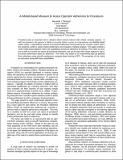A Model-Based Measure to Assess Operator Adherence to Procedure
| dc.contributor.author | Stimpson, A. J. | |
| dc.contributor.author | Buinhas, L. S. | |
| dc.contributor.author | Bezek, S. | |
| dc.contributor.author | Boussemart, Y. | |
| dc.contributor.author | Cummings, M. L. | |
| dc.date.accessioned | 2014-09-25T20:02:34Z | |
| dc.date.available | 2014-09-25T20:02:34Z | |
| dc.date.issued | 2012-10 | |
| dc.identifier.uri | http://hdl.handle.net/1721.1/90363 | |
| dc.description.abstract | Procedures play an important role in domains where humans interact with critical, complex systems. In such environments, the operator’s ability to correctly follow a given set of procedures can directly impact system safety. A quantitative measure of procedural adherence during training for complex system opera-tion would be useful to assess trainee performance and evaluate a training program. This paper presents a novel model-based objective metric for quantifying procedural adherence in training. This metric is sensi-tive to both the number and nature of procedural deviations, and can be used with cluster analysis to classi-fy trainee performance based on adherence. The metric was tested on an experimental data set gathered from volunteers using aircraft maintenance computer-based training (CBT). The properties of the metric are discussed, along with future possibilities. | en_US |
| dc.description.sponsorship | This research was conducted with support of Boeing Training and Flight Services. | en_US |
| dc.publisher | HFES | en_US |
| dc.subject | complex systems | en_US |
| dc.subject | training program | en_US |
| dc.subject | procedural adherence | en_US |
| dc.subject | computer-based training | en_US |
| dc.title | A Model-Based Measure to Assess Operator Adherence to Procedure | en_US |
| dc.type | Presentation | en_US |
| dc.identifier.citation | Stimpson, A.J., Buinhas, L.S., Bezek, S., Boussemart, Y, Cummings, M.L,. A Model-Based Measure to Assess Operator Adherence to Procedure, Proceedings of HFES 2012: 56th Annual Meeting of the Human Factors and Ergonomics Society, Boston, MA, October, 2012. | en_US |
Files in this item
This item appears in the following Collection(s)
-
HAL Reports
Technical Reports Series - Humans and Automation Laboratory
